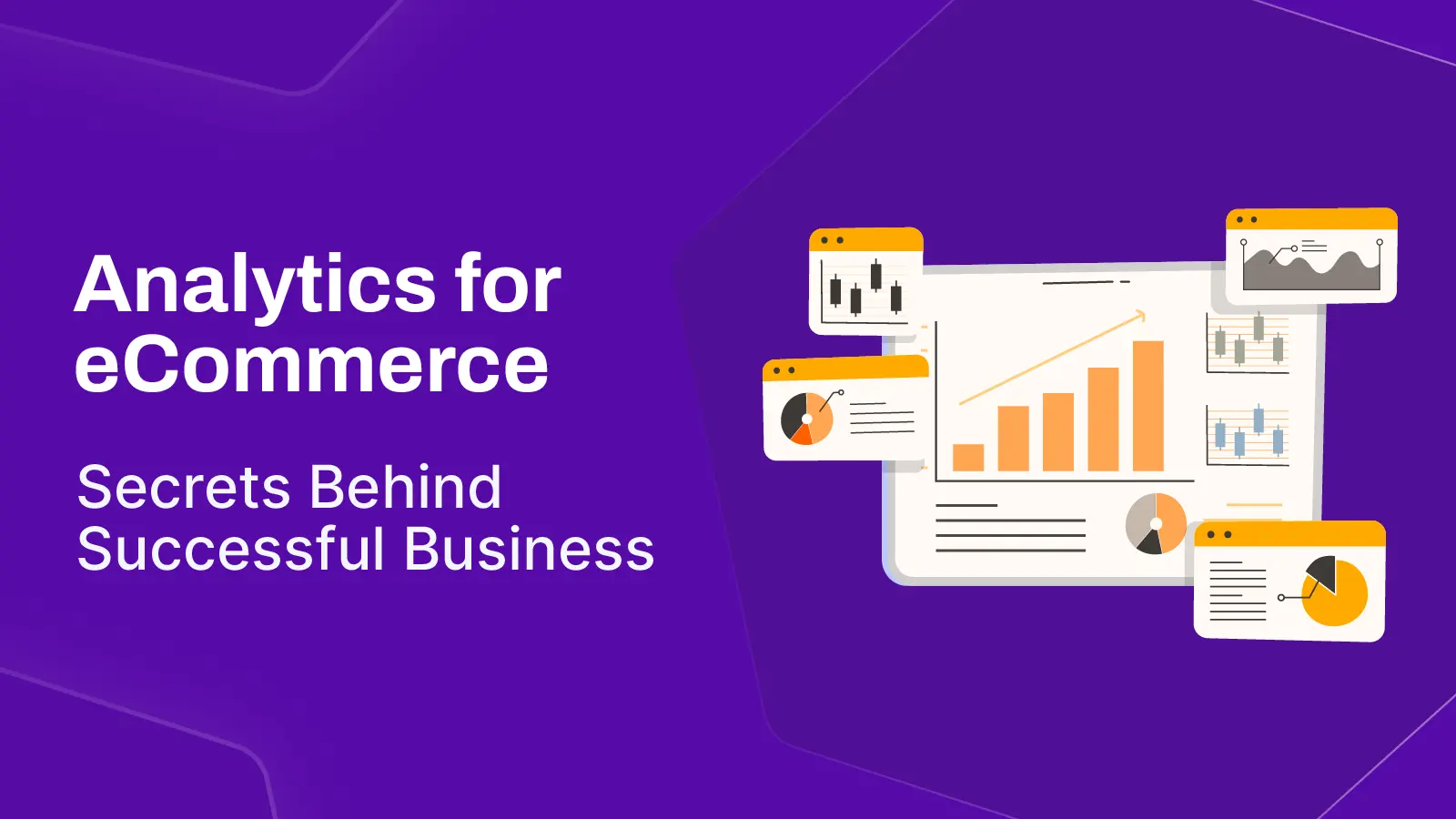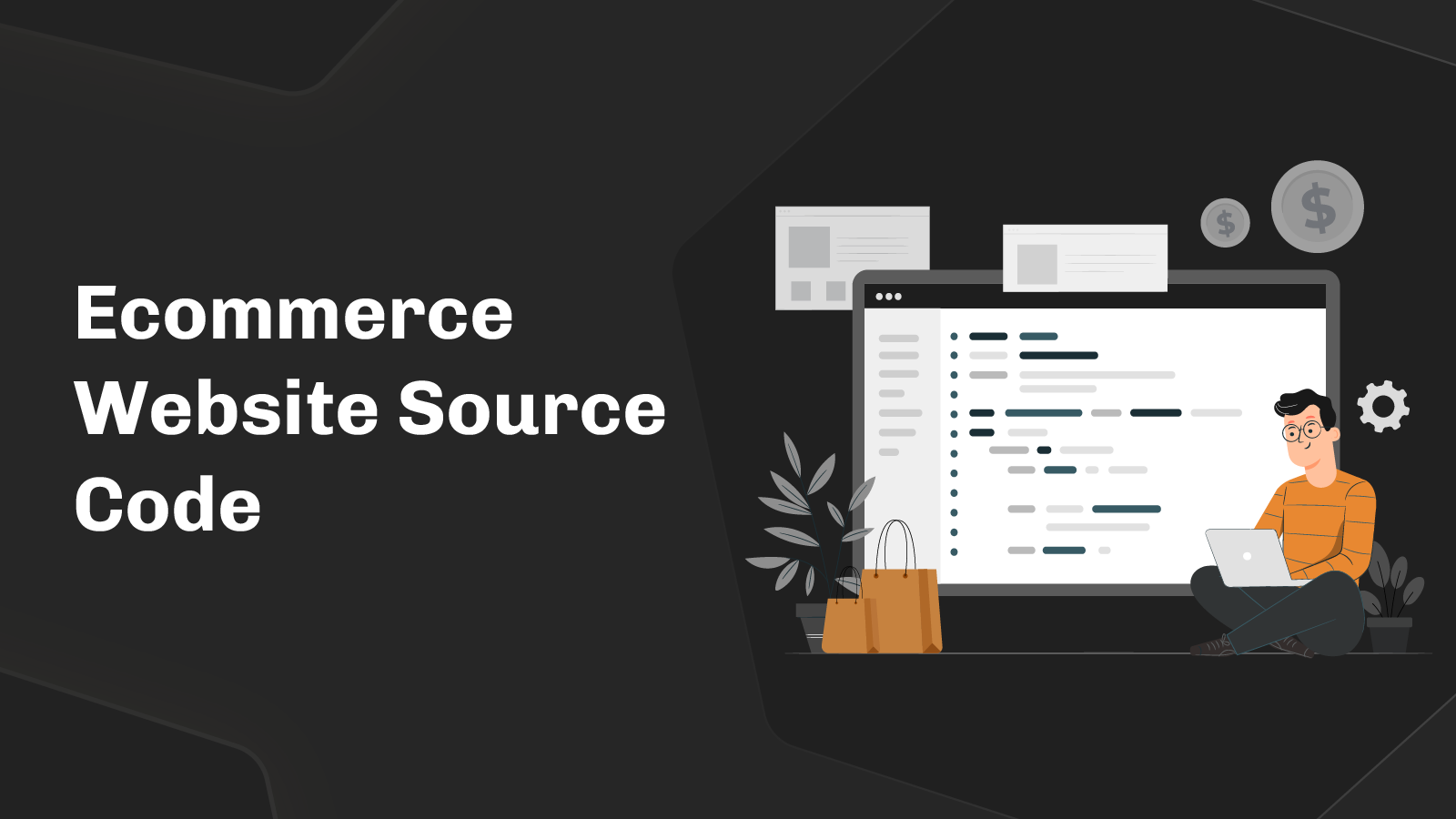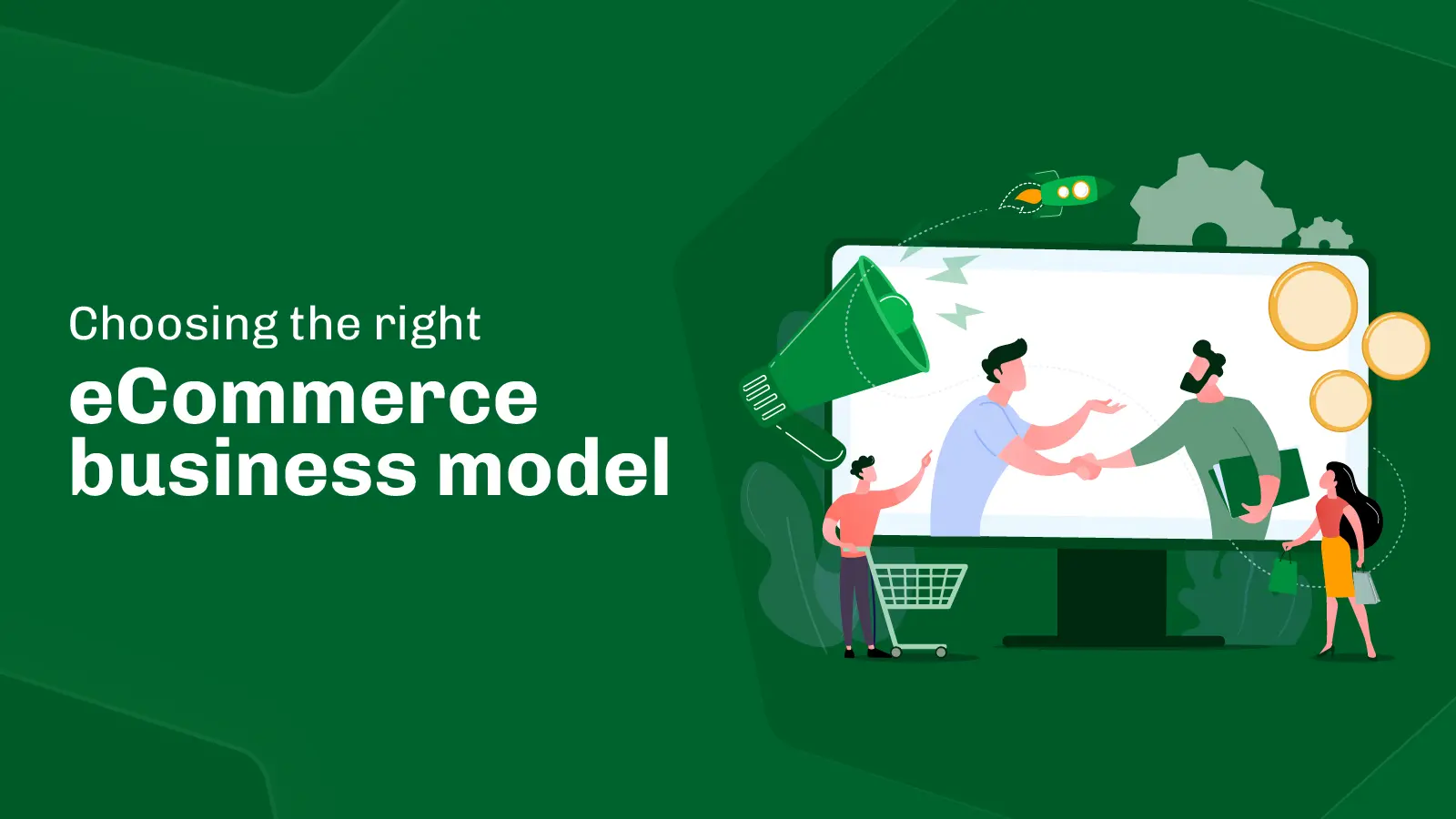These days, eCommerce has made shopping anything at anytime easier than ever. As opportunities increase, businesses find more room to launch, grow and expand.
The truth is more and more eCommerce sites are being created every single day. And why not? Everyone wants to take this golden opportunity!
But the question is, how many of them choose the right eCommerce business model? How many of them know the key components and right ways to operate their eCommerce business?
Well, this might be a lucky day for you to find this blog, as we will dive deep into the details of finding the right model to start an eCommerce business. It’s important to know the details and do homework so that you can put your best foot forward in the world of eCommerce.
What is eCommerce business model?
Before anything, we need to know the ABC’s. So, what is a business model? You can think of the business model as a central plan of your business.
Now, another question may come to your mind – What is a business plan? Well, it is a roadmap that outlines your business’s goals and tells you exactly how to achieve them. To gain profit from your business, you should have a set of planned activities that you will follow.
And think of the eCommerce business model as the specific way your online business will make and manage money while providing value for your customers. This model defines your products and services, online target market, and future expenses.
Types of eCommerce business models
Depending on the business size, features, opportunities, challenges, and many other contributing factors, the types of eCommerce business models can vary.
Knowing each model in depth would help you define yours – whether you’re new to it or want to elevate your existing one.
B2C ( Business-to-Consumer)
This is the most common and widely known form of eCommerce. In this model, you sell products or services directly to your customer or end user. There’s no intermediary seller between you and your consumer.
This type involves both – selling own products or selling from other vendors. A popular eCommerce solution that you can use for this business model is 6Valley. It comes with the benefits of having single and multivendor modes where you can sell physical or digital products.
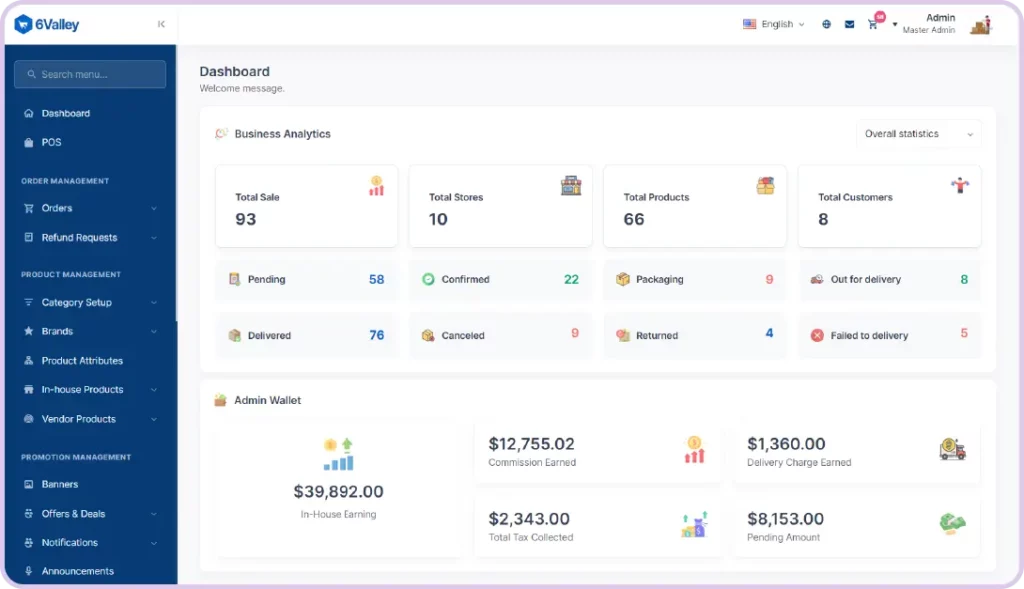
There are multiple types within B2C business models, including:
- Direct sellers
- Dropshipping
- Subscription-based
- Advertising based
- Community based
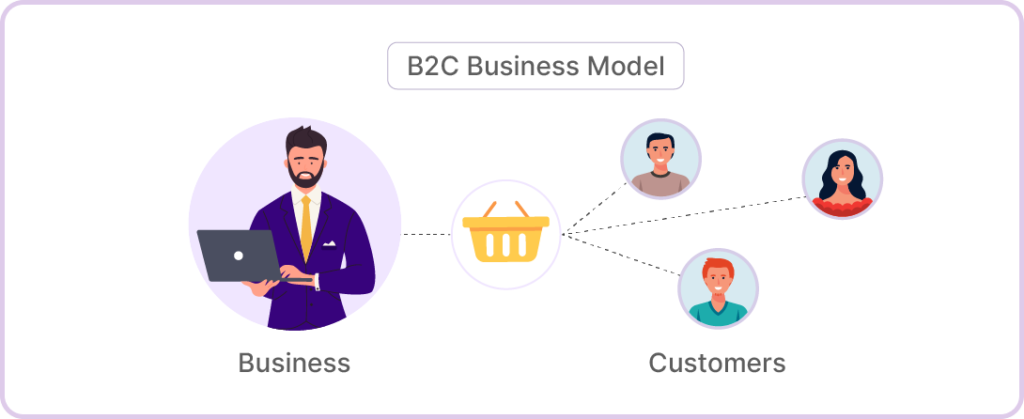
Key features of B2C:
- Interact directly with end customers and sell
- Possibility of reaching a global audience
- Give customers the convenience of shopping anytime, anywhere
Some examples of B2C industries include:
- Retail
- Fashion
- Health and Beauty
- Food and Beverages
- Automotive
- Streaming services
The B2C eCommerce market size is projected to grow from $6.5 trillion in 2023 to $8.3 trillion in 2026, with the Asia Pacific region dominating revenue. If done right, using the perfect market-ready solution, there’s a huge possibility for you to grow your business in this model.
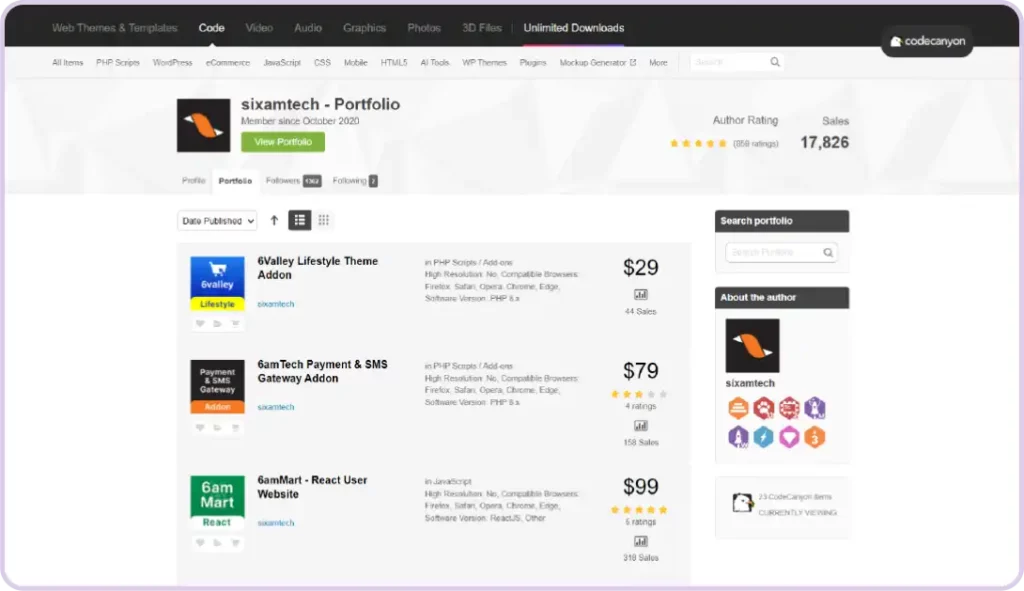
B2B ( Business-to-Business)
Simply put, it’s the commerce between two businesses.
Consider that you’re dealing with an intermediary business or intermediary buyer. This intermediary then sells the product to the ultimate customer or end user.
Still confused? Let’s make it more clear.
Imagine yourself as a seller of baking ingredients. You have a shop where you sell items such as flour, salt, dairy products, baking powder, baking soda, yeast, cocoa powder, and more. Now, a famous baker or shop owner comes to your store to purchase all the ingredients in bulk to make cakes. What does this mean for your business? It means you are selling goods to another baking business rather than directly to the end user.
For example, popular software solution and service provider 6amTech is a B2B brand. Most clients are business owners and developers who purchase from this company. Then, they start selling their products with market-ready solutions or customising them as per their client’s needs before reselling.
Key features of B2B:
- This may involve selling products in bulk
- Can offer custom solutions to business clients
- Opportunity to negotiate pricing and terms
- White label business where the online business sells unbranded products to resellers, who then brand and market them as their own.
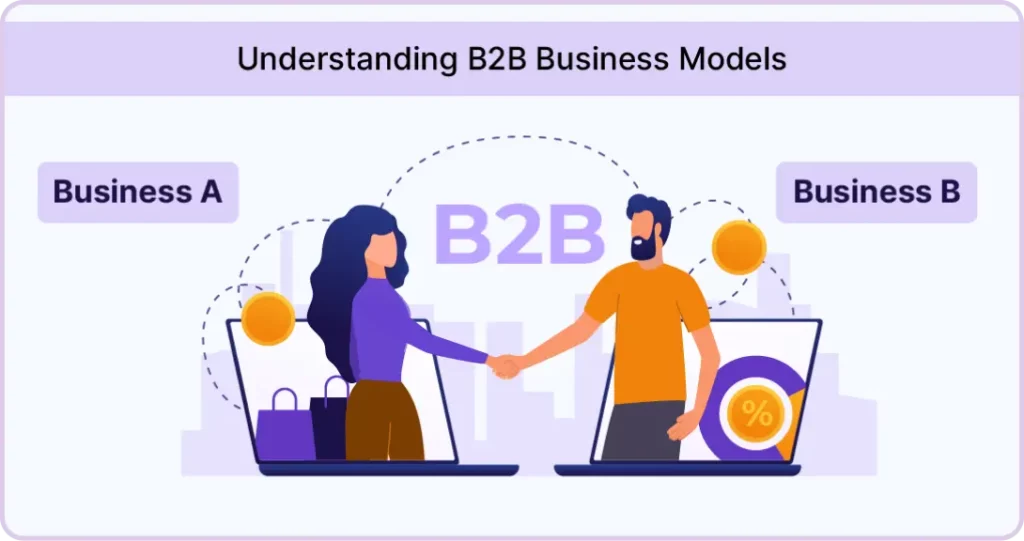
Some examples of B2B industries include:
- Manufacturing
- Wholesale
- Professional services
- Supply service ( Construction, Healthcare etc)
- Advertising and Printing
The B2B market is thriving and is projected to reach a value of $26.59 Trillion by 2030. Asia commands a significant 80 percent share in the global B2B eCommerce market, indicating vast opportunities in the region.
B2B2C ( Business-to-Business-to-Consumer)
Remember the last example of selling baking ingredients? Well, as a first seller, you sold them to a baker. Then the baker takes all the products and bakes cakes. Then what happens? Obviously, they sell it to someone who needs a cake for a birthday, anniversary, or any other special occasion.
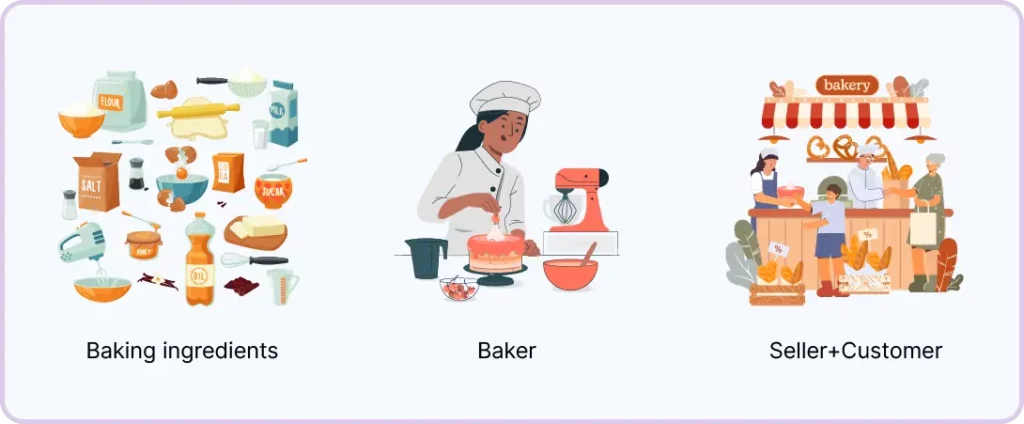
So, it means a business sells its products or services to another business, which in turn sells them to another end customer.
Key features of B2B2C:
- Two levels of transactions – Business to Business and Business to Consumer
- Intermediary business involvement
- Potential to reach a wider audience through the intermediary or middleman or wholesaler
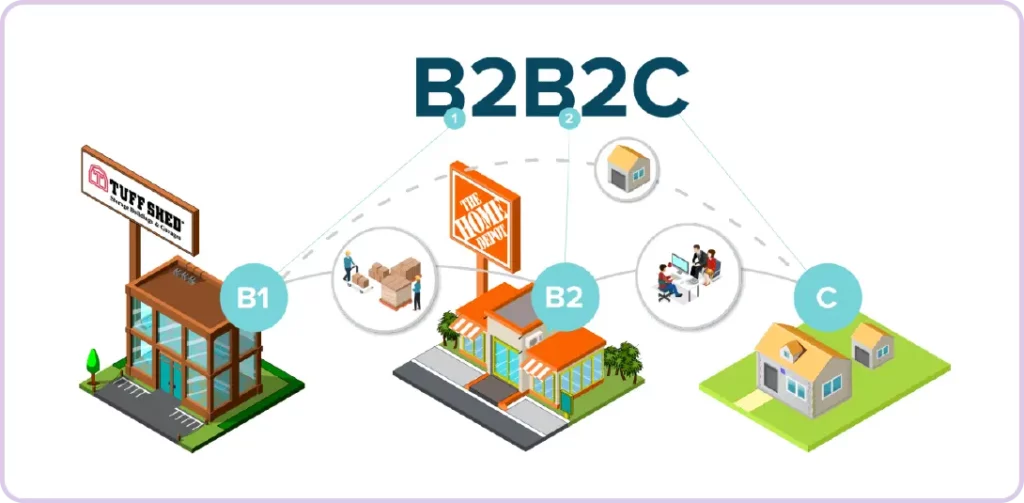
Some examples of B2B2C industries include:
- Technology Platforms
- Healthcare Platforms
- Insurance Brokers
- Marketplaces
B2B2C is a dynamic and highly competitive market with the possibility to grow significantly in the coming years.
B2G ( Business-to-Government)
In this model, businesses directly sell products or services to government entities. This model is for companies that exclusively work with government agencies. You can think of it as similar to B2B, but it offers services or products only to the government or administrators.
To run a B2G model business, you need to win government projects by pitching your ideas and services. But first, the government will announce RFPs.
Everything went over your head?
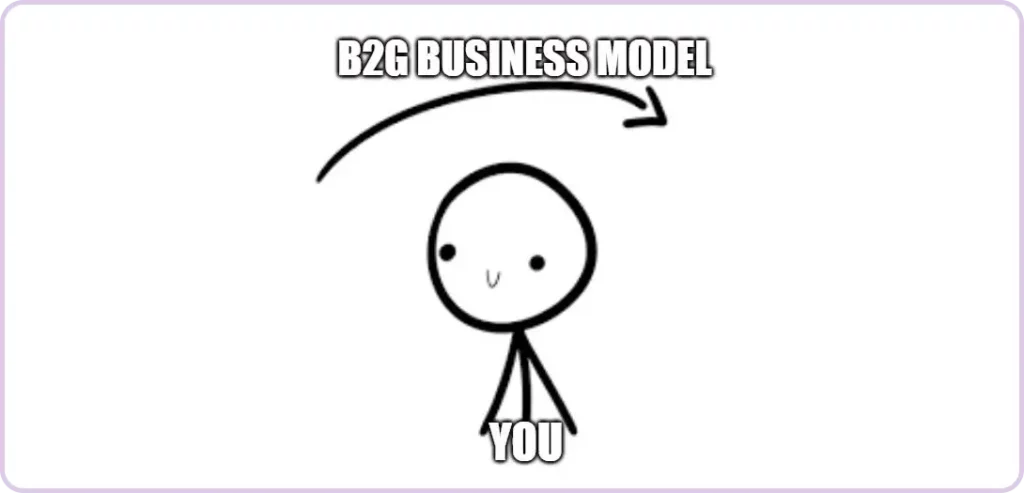
Well, we understand.
Let’s break it down in simple terms.
Imagine you have an eCommerce platform that sells medical equipment. The government in your country is building a new hospital and has announced a request for proposal (RFP). The reason is to solicit bids from contractors to complete this project. After bidding for the project, you met all detailed requirements and got the contract. Then, you supplied the required equipment and collaborated successfully with the government. That’s how the business-to-government model works.
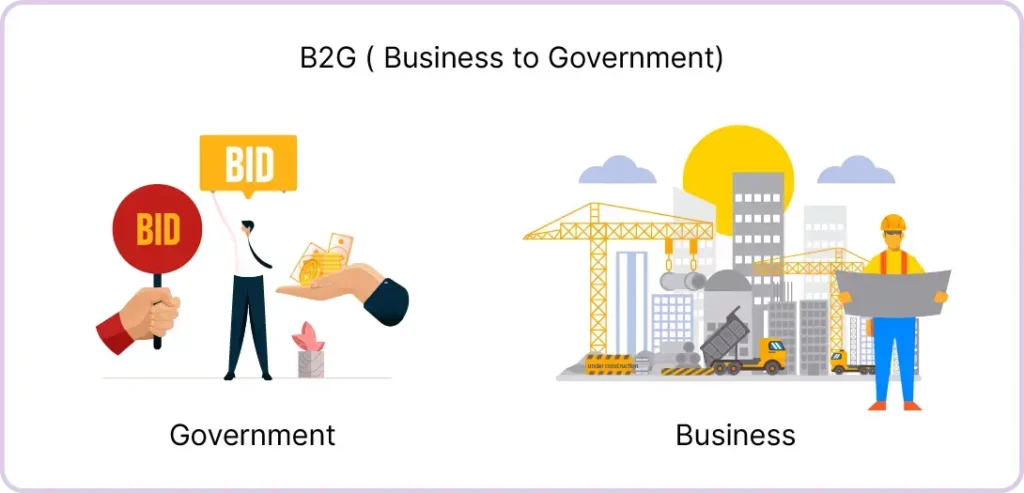
Some examples of B2G industries include:
- IT Services
- Security Services
- Defence Contractors
- Construction and Infrastructure
B2G eCommerce simplifies how businesses partner with government agencies. It ensures compliance with specific criteria and contributes to public projects.
C2C (Customer-to-Customer)
C2C is the transaction between two or more customers. It’s directly selling goods or products from one consumer to another consumer.
Mainly for this business model, a third-party website or marketplace is used. This 3rd party website or marketplace facilitates the transaction process.
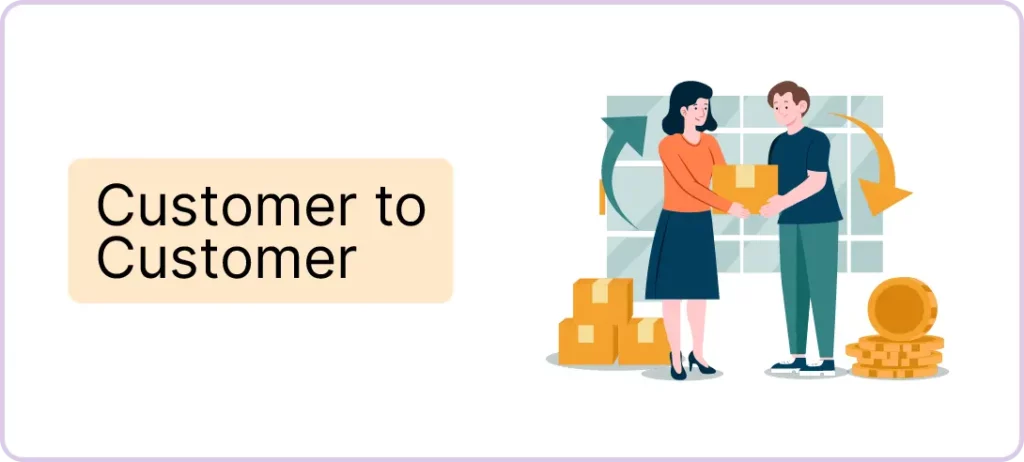
A great example is the Facebook marketplace. Imagine you have a closet full of trendy clothes you no longer wear. You want to get rid of them and make room for others in your wardrobe.
So what can you do? You go to a marketplace like Facebook and list your outfits with pictures, prices and additional details. When someone scrolls through the list and finds yours, they can buy directly from there. This way, your outfits get a new wardrobe, and you benefit from the earnings.
Key features of C2C:
- Customer to Customer transaction
- Variety of products
- Direct communication and negotiation opportunity
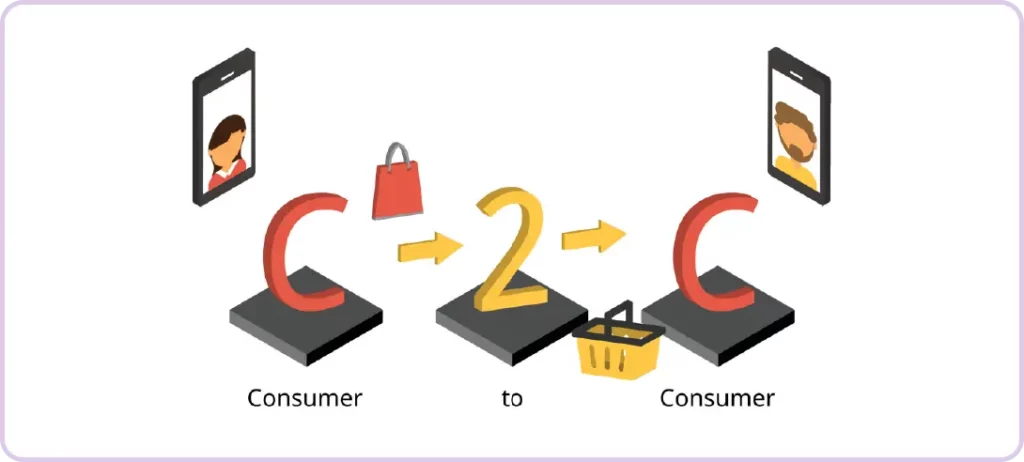
Some examples of C2C industries include:
- Online Marketplace
- Second Hand Fashion
- Peer to Peer Rentals
- Reseller Platforms
This model is considered a convenient and efficient way for consumers to buy and sell products. Many people prefer this model to earn extra money.
C2B (Consumer-to-Business)
Instead of getting goods from businesses, you as a consumer sell your products to businesses in this model.
For example, suppose you have a laptop that you no longer use. Your entrepreneur friend needs some equipment for his new business and you sold the laptop to him. So, as a consumer, you used the product for a while and sold it to a business that will use it for further needs. Instead of buying it from another computer shop, your friend bought it directly from a consumer like you.
Key features of C2B:
- Consumers directly providing products to business
- Consumers from various platforms can contribute
- Both consumers and businesses gain from the exchange
Example of the C2B industry include: Reselling Marketplace
The C2B model allows consumers to earn extra money while helping businesses in need.
D2C ( Direct-to-Consumer)
In this model, you will send the product directly to a consumer without any intermediary or middleman. You won’t have to follow the traditional channel to sell your goods or products. You will manufacture products and directly sell them to your customers.Suppose, you are a handicraft artist. You design and make your products and sell them directly to the customers. This will give you more control over your brand, especially pricing.
Key features of D2C:
- Bypassing intermediaries
- Control over brand
- Ownership and control over data
- Personalised customer experience
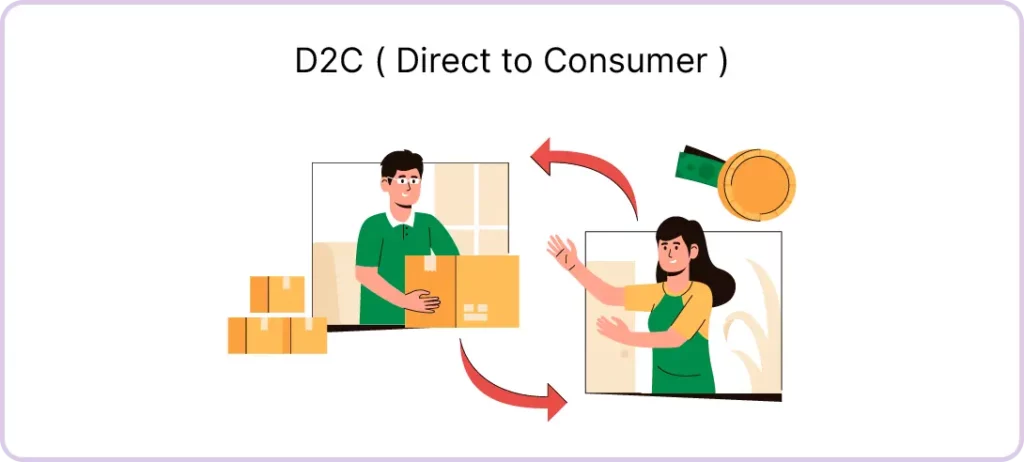
Some examples of D2C industries include:
- Pet Care
- Handcrafted Goods
- Food and Beverages
- Health and Wellness
- Apparel and Fashion
In the USA, direct-to-consumer sales are forecasted to reach $186 billion by 2025. In the Asian region, especially in India, companies like Sugar, Loom Solar, and The Moms Co are thriving in the industry.
What’s the difference between B2C, D2C, and B2B2C?
Now the question comes – if the product directly goes to the consumer from a business, what’s the difference between B2C and D2C? Why do we need even two different concepts that fulfil the same purpose – sending products to the customer?
Well, the difference lies in the equation of involving a middleman like a retailer or wholesaler. In the business-to-consumer model, you may get your goods for business from manufacturers or wholesalers. It’s obviously not a direct route. Take Coca-Cola as an example. They sell products to consumers but mostly through retailers. They are following the B2C model.
You may think then what’s the need for a B2B2C model if B2C and D2C are already solving the problems? So, B2B2C is one business that sells to another and then the middle business modifies or brands it as their own and sells it to the end user.
But imagine you are launching an eCommerce where you will sell products manufactured directly by you. There’s no involvement of a third party. You’re selling and shipping directly from your platform to your consumers. That’s what D2C is. For example, you can think of the famous luxury brand Louis Vuitton whose majority of sales revenue came from Direct-to-Consumer sales.
Let’s clear the confusion between B2C, B2B2C, and D2C in a nutshell:
B2C: Business sells to you.
B2B2C: Business sells to another business, and that business sells to you.
D2C: Manufacturer sells directly to you.
Key components of eCommerce business model
Before launching your eCommerce business, make sure you tick the checkboxes of key components. These components will help you make better decisions for your business and help you understand why your competitor or a particular company is dominating the market.
Value Proposition
Your company’s value proposition will define how your product or services are fulfilling the needs of your targeted audience. To identify the value proposition for your business, ask yourself questions like – “Why should your target audience buy from you?”
Revenue Model
This will help you plan how to make money from your eCommerce business. It can be done in different ways, including – an advertising model, subscription model, transaction fee model, sales model, affiliate model etc.
Market Opportunity
Before launching your business, it’s obvious that you have a targeted market whom you will serve. Market opportunity helps you identify the revenue potential your target market holds.
Think about the marketplace you’re going to serve and the size of it to make better decisions.
Competitor Analysis
You’re not alone in the field. Someone is already doing the kind of business you have always wanted to launch. Does it mean you will sit back and do nothing for your business? No. You will analyse their performance and find gaps to serve your audience.
After researching your competitors, you will have a vast idea about their offerings, pricing, and packages. What advantage does it bring? Well, it helps you produce products or offer services superior to them. Also, sometimes lets you bring the product or service comparatively at a lower price than most of your competitors. It will make your target audience buy from you or take your services more if there’s no compromise with the quality.
So, a competitive environment helps you identify other companies operating in the same marketplace and selling similar products.
Market Strategy
Define how to promote your products or services to attract your target audience. Make a detailed plan on how you intend to enter the marketplace to attract new customers. Remember, even if you have the world’s best concept for an eCommerce business but didn’t market it properly or didn’t showcase it to your potential customers, it might not perform as you expected.
Online Store
The first and foremost thing you need to launch and make your business available in front of your audience is an online store. Typically your store will list products with pricing, checkout and payment processes.
Product Sourcing
As an eCommerce business owner, you may source your products from different wholesalers, retailers or third parties. Also, you can manufacture the whole thing by yourself. For a perfect eCommerce business model, you must pre-define and ensure you’re sourcing products from a trusted source.
Product Shipping and Delivery
Imagine you ordered from an eCommerce store, and it’s taking years to be delivered. Frustrating right? So for your own business, you need to make a logistic infrastructure or involve a third party who will deliver products on time.
Customer Service
You sell amazing products, and your website looks absolutely incredible full of products; you deliver on time, and everything in your business operation is smooth. Suddenly, one customer is facing some issues regarding a product they ordered, and now they find no service option from your online store and started complaining on the online forums. Do you want that to happen? If the answer is ‘No,’ you must provide your customers support through email, phone, live chat, or any other convenient medium.
Management Team
Finally, you have tick-marked all the key components to run a successful eCommerce business. But your model lacks one thing – a team that will execute your plan. The employees or management team will be responsible for making your business model work. For that reason, evaluate the experience and background someone needs as a company’s leader or to run an online store.
Which eCommerce business models do popular platforms follow?
Ever wondered how giant eCommerce companies are generating revenues? Even if you didn’t, it’s time to look at the footprints that led them to success.
Amazon
Business Model: B2C (Business-to-Consumer) and B2B (Business-to-Business)
Key Features: Online retail platform connecting sellers directly to consumers.
Walmart
Business Model: B2C (Business-to-Consumer)
Key Features: Operates as a large retail platform connecting businesses to online and offline consumers
iTunes
Business Model: B2C (Business-to-Consumer)
Key Features: Offers a digital storefront where consumers can purchase and download music, movies, and other media directly.
Uber Eats
Business Model: B2B (Business-to-Business) and B2C (Business-to-Consumer) Key Features: Facilitates consumers ordering from businesses (restaurants) for delivery.
Finding Your Fit: How to Choose the Right eCommerce Business Model
Feeling overwhelmed after reading all this? Need help in choosing for your business?
Worry not; after reading this, you will be able to finalise your business model easily.
Ready?
Ok, first, you will have to ask yourself some questions and answer them honestly-
- What type of product are you going to sell? Is it physical products, digital products or services? Understanding your offering clearly will give you more clarity.
- Do you know who your target audience is? If you know the pain points of your target audiences and sell exactly the product or service they need, chances are you’ll become successful.
- Do you have enough resources to start with your eCommerce business? A budget plan, team and available technologies will help you decide and work on the model faster.
- How are you going to position your brand on digital platforms? – You know your products are top-notch, but does the audience know? Deciding on implementing digital marketing methods while choosing the right business model will keep you ahead
Now, if you have defined the answers to those questions, let’s look at the section below that gives comprehensive ideas of different business models.
The B2B (Business-to-Business) eCommerce model best suits wholesale, manufacturing businesses, service providers, tech companies and SaaS providers.
The B2C (Business-to-Consumer) eCommerce model is ideal for businesses like retailers, online stores, and service providers for products or services used personally etc.
If your target audience is another business selling products to end users, then B2B2C would be the ideal model.
Go for B2G (Business-to-Government) if you want to market your product or services directly to government agencies.
The C2C (Consumer-to-Consumer) model is ideal if your platform or service enables individuals to buy and sell goods or services.
If you plan to offer products directly to businesses or build a platform as a consumer to serve only businesses, opt for the C2B model.
If you want to build a business platform where skilled consumers can directly interact with government agencies and work with them, then C2G would be the right fit model.
The D2C (Direct-to-Consumer) business model will allow you to manufacture your products and directly sell them to your customers without involving any intermediary.
Final Words
Planning is crucial for every business. But before planning your business strategies, you need to understand the eCommerce business model to have a better grip over the marketplace.
Most of your ideas will fall into any of the mentioned models in this blog. Always remember to keep the key components in your mind and ask yourself pre-launch questions to get a clear idea. After deciding on a business model, we would suggest using a readymade, launch-ready solution to cut your worries in half.
If you need further help finding the right readymade solution or help deciding the perfect model for your idea with an appropriate solution, connect with us without any hesitation. Don’t think about whether your questions are even logical to ask. Just ask us and get the answer.















